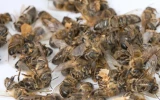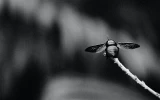10 Most Common Bee Types (With Pictures to Identify)
Bees play a crucial role in our ecosystem, with over 20,000 species buzzing around the globe. Among these, ten species stand out for their commonality in gardens and their affinity for flowering plants, and each type has its unique behaviors and contributions, especially in pollination. In this article, we'll provide a visual guide with pictures and descriptions of the most common bee types to help you identify them.
The most common bee types include honeybees, bumblebees, carpenter bees, mason bees, leafcutter bees, sweat bees, squash bees, blue orchard bees, mining bees, and stingless bees. These bees vary in size, coloration, nesting and foraging behavior, but all play important roles in plant pollination.
Some lesser-known bees might not make honey, but they're champion pollinators in their own right, hinting at the vast, often overlooked diversity of the bee kingdom. While you might think of bees as just honey-makers, there's a lot more buzz about them.
Summary
- Bees have significant financial and ecological impacts, from the high-value role of honeybees in agriculture and the honey industry to the mixed effects of carpenter bees, which benefit pollination but can damage wooden structures.
- Solitary bees, including mason and leafcutter bees, offer critical pollination services with minimal maintenance, enhancing crop yields and biodiversity.
- Certain bees, such as squash bees and blue orchard bees, specialize in pollinating specific plants, demonstrating nature's fine-tuned relationships.
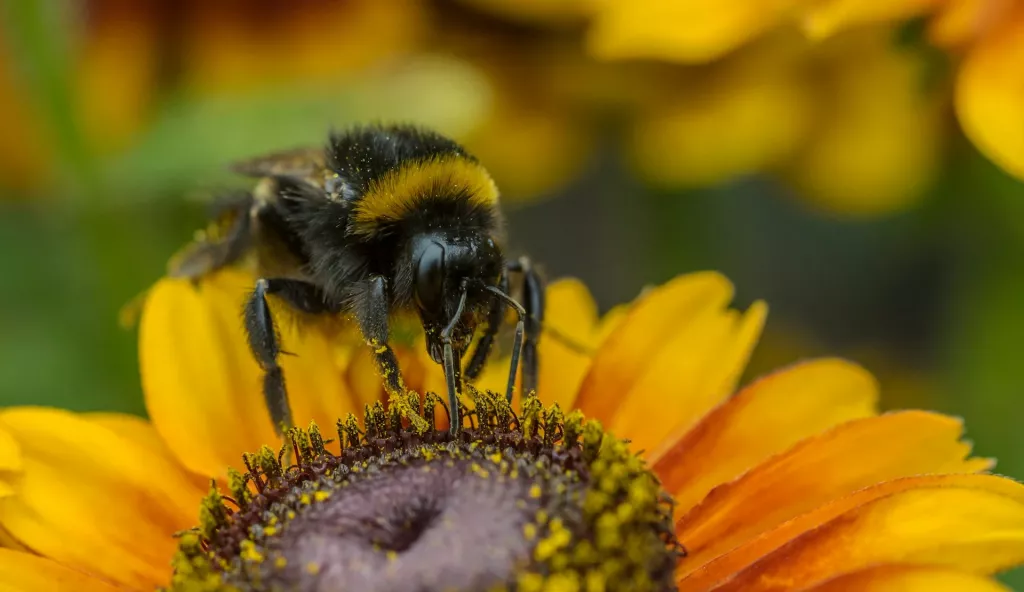
On this page:
You might be familiar with the honeybee, famous for producing honey, but there are many other species that are just as important. Each species has distinct behaviors and roles within their ecosystems.
Bees exhibit diverse social structures, ranging from the complex, hierarchical societies of honeybees and stingless bees to the solitary existence of species like carpenter bees, mason bees, and leafcutter bees. Take a look at this table.
| Bee Species | Key Characteristics | Habitats & Behavior | Financial Impact |
|---|---|---|---|
| Honeybees | Live in hives with queen, workers, drones. Produce honey. | Managed hives, some feral hives. Social, coordinate hive activities. | High, crucial for agriculture and honey industry |
| Bumblebees | Larger, furry bees. Live in small colonies with queen. | Underground nests, grasslands. Social but small colonies. | Significant, especially for greenhouse crops |
| Carpenter Bees | Solitary bees that tunnel into wood to nest. | Wood structures, trees, fences. Solitary nesters. | Mixed; beneficial for pollination but can cause structural damage |
| Mason Bees | Solitary bees that use mud or leaves to make nest cells. | Natural cavities like hollow stems. Solitary nesters. | Positive, used in orchard pollination, low maintenance |
| Leafcutter Bees | Solitary bees that cut leaf pieces to line nests. | Nests in cavities. Solitary nesters. | Positive, effective pollinators with minimal damage to plants |
| Sweat Bees | Small solitary bees attracted to sweat. Metallic colored. | Ground nesters. Solitary nesters. | Positive, contribute to ecosystem diversity and crop pollination |
| Squash Bees | Specialist pollinators of squash plants. | Ground nesters. Solitary nesters. | Positive, crucial for the production of squash and related vegetables without requiring managed pollination |
| Blue Orchard Bees | Solitary bees, specialized for fruit tree pollination. | Nests in cavities. Solitary nesters. | Very positive, efficient in orchard pollination, reducing need for honeybee rental |
| Mining Bees | Solitary ground-nesting bees. | Underground nesters. Solitary nesters. | Positive, enhance pollination diversity and effectiveness, especially in natural ecosystems |
| Stingless Bees | Tropical social bees that do not sting. | Colonies in tree hollows, hives. Social colonies. | Positive, produce honey in the tropics |
Honeybee (Apis mellifera)
The honeybee, specifically Apis mellifera, plays a crucial role in pollination, which is essential for diverse flowers and crops. This bee species, commonly referred to as the western honey bee, is known for producing honey and establishing complex colonies within their hives.
A single honeybee colony houses a queen, numerous worker bees, and drones. Worker bees are responsible for multiple tasks, from gathering nectar to caring for larvae. Their bodies are equipped with hairs that trap pollen, which aids in the fertilization of plants.
Honeybees have excellent eyes; they help them find food sources. They communicate through dances. Apis mellifera is not native to the United States but has become a prominent part of the ecosystem, often farmed by beekeepers.

While typically harmless to humans, honeybees can sting when provoked. They are susceptible to mites and parasites, which can harm their population. Despite challenges, their value in supporting vast agricultural systems makes them indispensable.
Bumblebee (Bombus spp.)
Bumblebees are a friendly presence in your garden, easily recognizable by their furry bodies and distinctive buzzing sound. Unlike some of their insect relatives, such as ants and wasps, bumblebees are not generally aggressive and are known for their beneficial role in pollination.
When you see them flitting from flower to flower, they are collecting nectar and pollen to bring back to their hive.
These bumblebees display a variety of color patterns, often sporting the familiar striped pattern of black and yellow. The Bombus genus, which makes up the bee families known as bumblebees, is distinguished by a round, furry appearance and is larger than the yellow-faced bees, another group of pollen lovers.
In identifying bees, look for the bumblebee’s robust body and the way they hover around flowers. You can often spot them in gardens, providing a crucial pollination service. Each species has its own habitat preferences, but most are adaptable, living in a range of environments, from farmlands to urban backyards.
Bumblebees have strong mandibles used for manipulating flowers to access nectar, and this interaction is why they are so important for healthy flowering ecosystems.
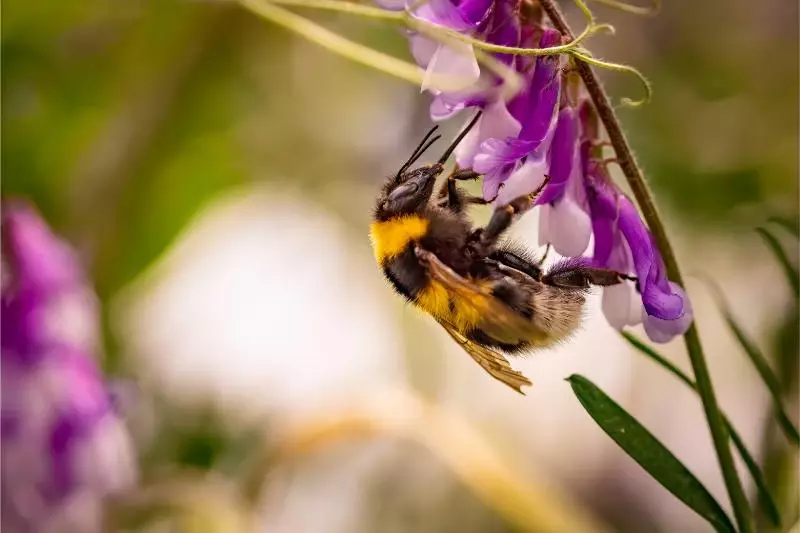
To identify a bumblebee specifically, look for the short, even coat of fur and the absence of a narrow “waist” like that of a wasp. These fuzzy insects are integral to your local ecosystem, ensuring that your garden remains a blossom-rich haven.
Carpenter Bee (Xylocopa spp.)
Carpenter bees are fascinating creatures that you might encounter buzzing around your garden. These bees belong to the genus Xylocopa. They are known for their robust size and their unique nesting behavior. Unlike the more social honey bees, carpenter bees are solitary bees, which means they do not live in large colonies.
Their name comes from their habit of burrowing into wood to create nests. This can lead to them being mistaken for pests, but they rarely cause significant damage.
A carpenter bee nest is usually made in soft, unpainted, or weathered wood, where they carve out tunnels to lay their eggs. You might notice a pile of sawdust beneath a hole in a wooden structure, an indicator of their presence.
Adult carpenter bees are large, comparable in size to bumblebees, and can appear to have a shiny, black body. Some species have a tan or gray fuzz on their abdomens, making them easier to identify. Despite their daunting size, they are generally docile and are less likely to sting compared to other bees like the more aggressive killer bee.
Carpenter bees prefer to keep to themselves and their interaction with humans is minimal. If you spot a solitary bee hovering around wooden structures, chances are it's a carpenter bee, busily going about its daily routine.
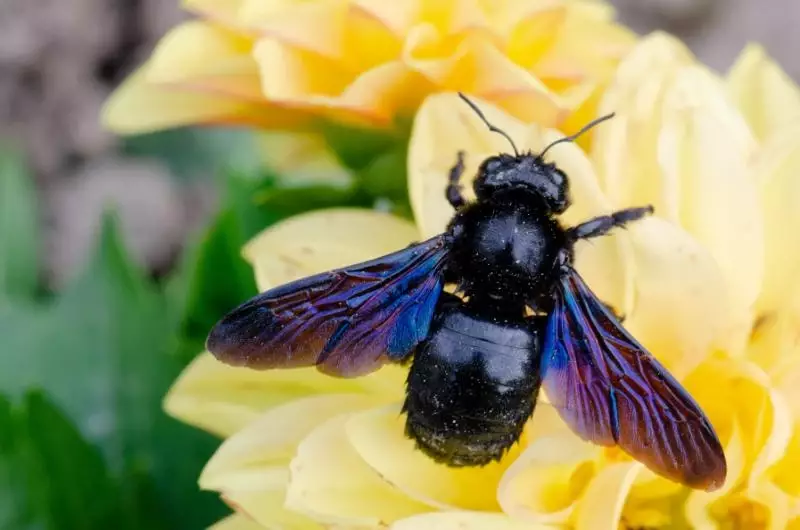
If you're curious how long do carpenter bees live, find out here.
Mason Bee (Osmia Spp.)
Mason bees are your friendly neighborhood pollinators, playing a vital role in the health of your garden. Unlike their better-known relatives, honey bees, mason bees are solitary creatures. Each female is able to reproduce and construct her own nest, often in pre-existing holes in wood or hollow stems.
Here's what you should know about their appearance: they have a robust, compact body with a dense pile of hairs on their thorax and abdomen. Their wings tuck neatly at their sides when at rest. These bees exhibit a variety of colors, with some species like the blue orchard mason bee showcasing beautiful metallic blue hues.
You'll often find mason bees buzzing around flowers in your garden. They are incredible pollinators, especially for fruits and vegetables like blueberries and apples.
Mason bees carry pollen on the underside of their abdomen where the hairs are located, which allows them to efficiently transfer pollen from one bloom to another.
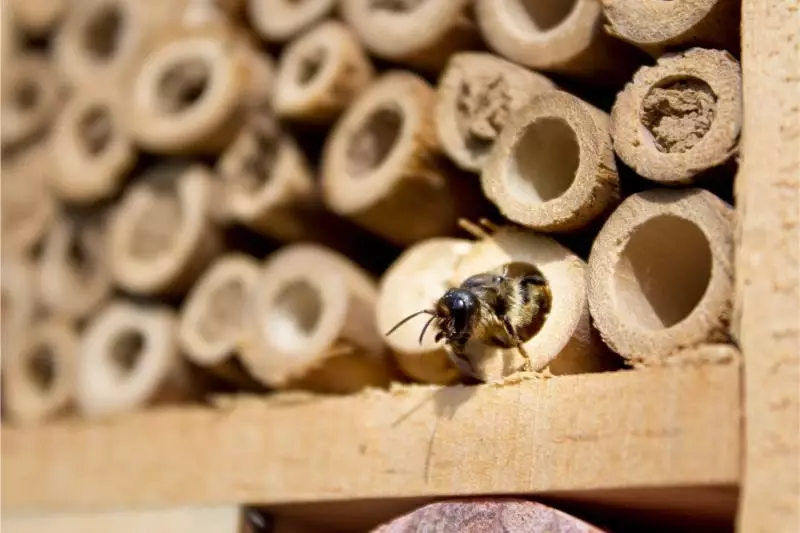
When planning your garden, remember that mason bees are native to many parts of North America. They appreciate a variety of flowering plants and can help increase the yields of your fruiting plants.
To attract these beneficial insects, consider setting up a mason bee house or leaving natural nesting sites such as hollowed-out stems or drilled blocks of wood, ensuring the continued health and variety of your home ecosystem.
Leafcutter Bee (Megachile spp.)
Leafcutter bees are intriguing members of the bee family known for their unique nesting behavior. They belong to the genus Megachile, which is part of the larger family Megachilidae. The females exhibit a distinctive habit of cutting leaves to construct their nests.
These bees are solitary pollinators, each female typically works alone to build nests and provide for her offspring. Despite being solitary, they are crucial for pollinating a variety of flowering plants, including those in your gardens.
The body structure of leafcutter bees is an adaptation for collecting pollen; they have hairs beneath their abdomen called scopa which are essential for carrying pollen back to their nests.
You can identify a leafcutter bee by its size and shape; they're approximately the size of a common honeybee. However, they are darker with bands of light on the abdomen. Their antennae and thorax are also characteristically robust. When searching for food, these bees prefer plants with ample nectar and pollen, ensuring a healthy diet for their larvae.
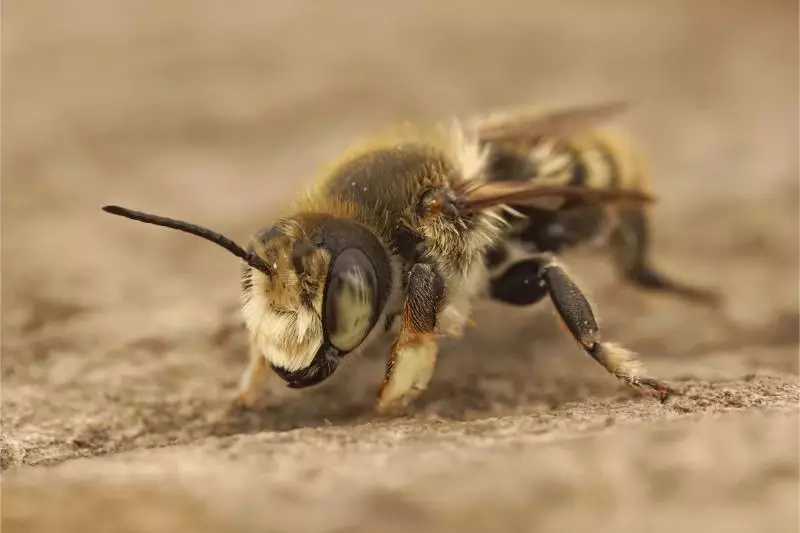
Leafcutter bees, like their relatives the osmia, are friendly guests to have in your garden as they are non-aggressive and efficient pollinators. Their presence helps maintain healthy and green environments by aiding in the pollination of a wide array of plants.
Encouraging leafcutters in your garden is simple: provide them with a variety of native flowers that bloom at different times of the year.
Sweat Bee (Halictidae family)
Sweat bees, belonging to the family Halictidae, are a fascinating group amongst different types of bees. You'll typically find them in your garden, playing a crucial role in pollination. Their name originates from their attraction to human perspiration, and though they have a sting, they are often non-aggressive and only sting when provoked.
Sweat bees exhibit a dazzling array of colors, often with metallic green to black bodies. Their small, streamlined bodies feature two wings, a slender thorax, and an abdomen that supports their energetic flight.
What makes sweat bees standout is often their size, as they're smaller than many other bees, with thin legs and antennae that they use to navigate and explore their environment.
These bees are not only native to many regions but also contribute significantly to the local ecosystem's health. You'll notice them hovering over flowers, as they're important pollinators for both wild plants and those in your garden.
Sweat bees carry pollen on their hind legs, moving from one bloom to another, aiding in the growth of plants and the diversity of the population.
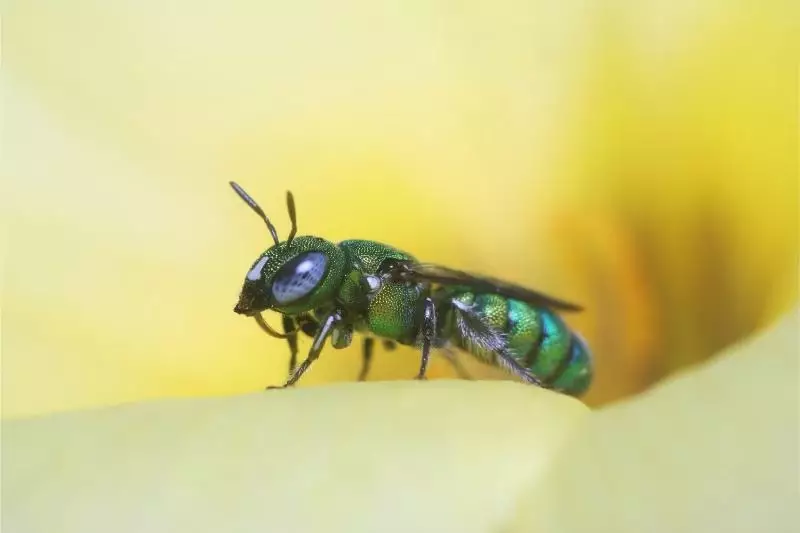
Sweat bees can vary greatly, with over 1,000 species in varying habitats. When observing these bees, notice the subtle differences and appreciate their role in keeping our gardens thriving.
Squash Bee (Peponapis pruinosa)
The Squash Bee, or Peponapis pruinosa, is an important pollinator for your squash and pumpkin plants. These bees have a special relationship with cucurbit plants, which include various squash, pumpkins, and gourds.
As solitary bees, squash bees don't live in hives like honeybees. Instead, they nest in the ground, often near the plants they pollinate.
You'll recognize squash bees by their size, which is slightly larger than a honeybee, and their dense hairs ― pale orange on the thorax and with off-white bands on the abdomen. They're native to North and Central America, thriving wherever cucurbits are grown.
Squash bees forage for pollen early in the day, making them less visible than other bees during peak garden hours.
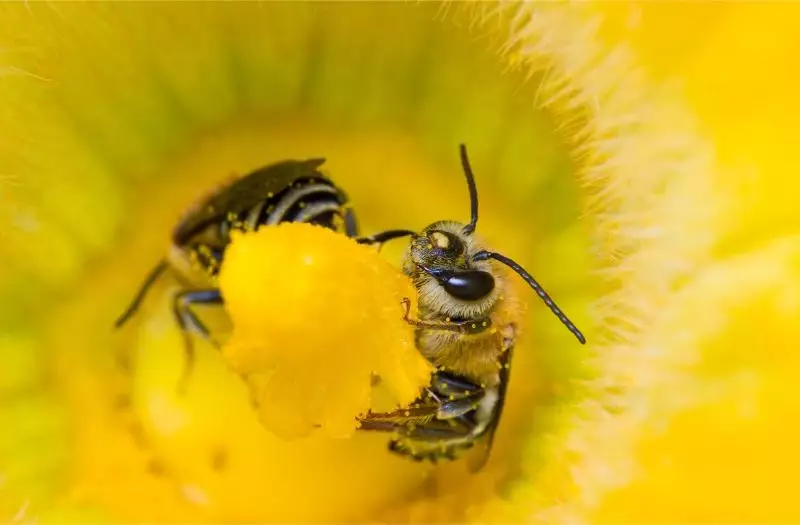
Your garden benefits from these bees, particularly if you grow cucurbits. Unlike sweat bees or osmia, the Squash Bee focuses on squash flowers, ensuring your fruits and vegetables are well-pollinated. Cultivating a home for these bees is simple; allow some bare, undisturbed soil in sunny spots for their nests, and they will happily return the favor by pollinating your crops.
Blue Orchard Bee (Osmia lignaria)
The blue orchard bee, also known as Osmia lignaria, is a beneficial species to your garden due to its efficient pollination abilities.
Unlike honeybees, these are solitary mason bees, meaning they don't live in hives but make their nests in small cavities. This trait makes them particularly useful for pollinating fruit trees, such as apples and almonds.
Their stunning color is a metallic blue, quite unlike the typical yellow and black striped pattern of many bees. These bees carry pollen on the underside of their abdomen as opposed to the legs like many other bee species. As they visit flowers, their fuzzy bellies pick up and transmit pollen effectively, making them excellent pollinators.

If you're looking to attract blue orchard bees to your garden, keep in mind that they are native to North America and thrive in habitats that offer suitable nesting sites. Providing mason bee houses with small tubes or drilling holes in wood can encourage them to stay and help pollinate your plants.
Blue orchard bee are docile bees that are unlikely to sting and thus can be a gardener's friendly ally in maintaining plant health and encouraging a bountiful garden.
Mining Bee (Andrenidae family)
Miner bees, or scientifically called "mining bee", part of the Andrenidae family, are a group of solitary, ground-nesting bees. You might encounter over 1,200 species in North America alone. These bees are important pollinators, and they vary widely in appearance.
You will typically find these bees in various habitats, ranging from woodlands to gardens. Their nesting habits are unique; they excavate tunnels in the ground to lay their eggs. Each female miner bee works alone to create her nest.
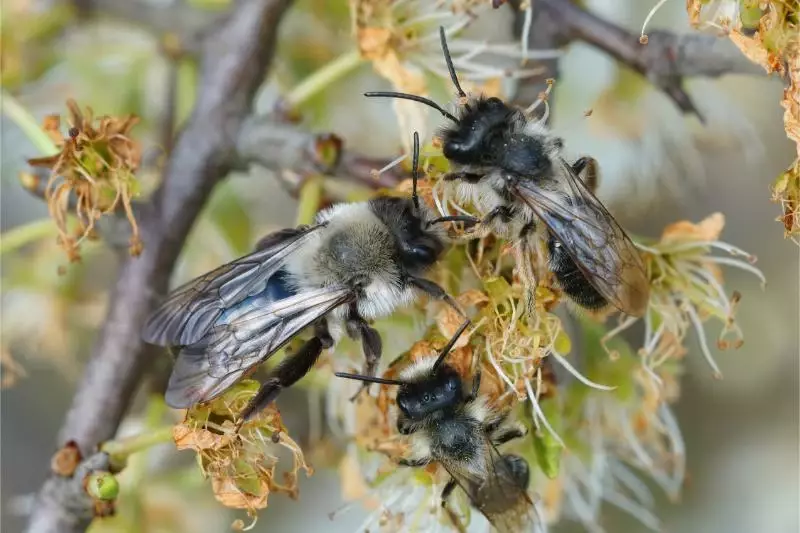
Miner bees are usually dark and may seem nondescript at first glance. Their sizes range from small to large, and they may visit a variety of plants to collect pollen and nectar. Since they are solitary, you won’t find them living in hives or producing honey.
Stingless Bee (Meliponini Tribe)
Stingless bees are nature's remarkable pollinators, inhabiting tropical and subtropical regions. You’ll find them in environments as varied as Australia, Africa, Southeast Asia, and the Americas. This group comprises approximately 500 species, making it quite diverse.
Stingless bees are generally small, ranging in size from 4 to 11 mm, and live in highly organized social colonies. Although they lack a stinger, they may bite or use sticky resin to fend off predators.
Stingless bees build their nests in a variety of locations, including hollow trunks, tree branches, underground cavities, or even rock crevices, and are known for their unique foraging patterns, collecting pollen and nectar for their colonies.
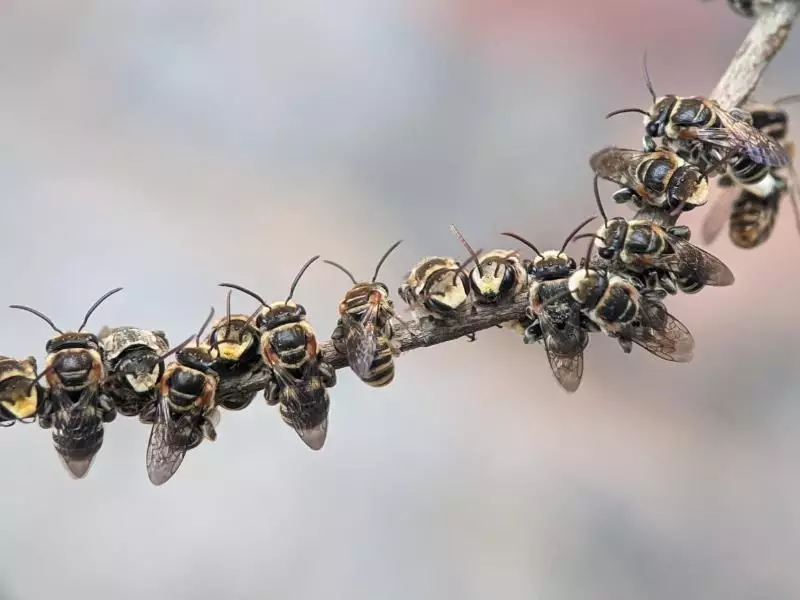
Unlike their well-known relatives, stingless bees produce honey, albeit in smaller quantities. Some species like Melipona beecheii are significant for their role in local agriculture and for cultural practices, particularly in Central America.
Another point of interest in stingless bees is their intricate nest design, which often features beautiful spiral structures, maintained by worker bees.
Stingless bee conservation is vital due to their crucial role in the pollination of local flora, facing threats from habitat destruction and climate change, with protection efforts focusing on preserving their habitats and employing sustainable beekeeping practices.

